Konica Minolta Maxxum 5DQuickly on the heels of its first dSLR, Konica Minolta shrinks the form factor and the price without losing in-camera image stabilization.<<Video, Power & Included Software :(Previous) | (Next): Reference: Datasheet>> Page 12:Test Results & ConclusionReview First Posted: 10/31/2005 |
Test Results
To see a complete listing of all our test shots and do your own analysis, go to the Thumbnails page.
Lens
Zoom
The kit lens ranges from 18-70mm (35mm equivalent), generous at the wide angle end, with macro focusing as close as 1.3 feet (0.38m).
|
18mm
|
70mm
|
The Konica Minolta Maxxum 5D zooms over the equivalent of an 18-70mm range, equivalent to a 27-105mm lens on a 35mm camera.
Macro
Focusing as close as 1.3 feet (0.38m), the minimum capture size is 2x3 inches.
|
Standard Macro
|
Macro with Flash
|
The Konica Minolta Maxxum 5D kit lens performed reasonably well in macro mode, capturing a slightly large minimum area of 3.07 x 2.04 inches (78 x 52 millimeters). Offsetting the slightly large minimum area though is the 5D's excellent corner to corner sharpness and very low distortion. Most digital cameras we test get very soft in the corners of the frame when shooting close-ups, but the 5D largely avoids that problem. (There is a little softening at the very edges, but it's dramatically less than is usually the case.) The 5D's flash also throttles down quite well for macro shots, and illuminates the subject very evenly.
Distortion
Average pincushion distortion, no pincushion at all.
|
Barrel distortion at 18mm (27 mm equiv) is 0.85%
|
 |
|
Very little pincushion at 70mm (105mm equiv), 0.13%.
|
 |
Chromatic aberration
Very low chromatic aberration across the focal length range.
|
Slight to Moderate CA, wide angle
(200% magnification) |
Very little, telephoto
(200% magnification) |
Chromatic aberration in the Konica Minolta Maxxum 5D is quite low, showing only 2-3 pixels of moderately bright coloration on either side of the target lines at wide angle almost no color at all at telephoto lens settings. (This distortion is visible as a very slight colored fringe around the objects at the edges of the field of view on the resolution target. - NOTE that the illustrations above are shown at 200% magnification, the actual distortion is half that shown.)
Corner Sharpness
Very slight softening in the corners, worse at telephoto.
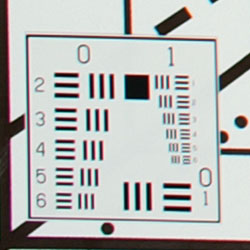 |
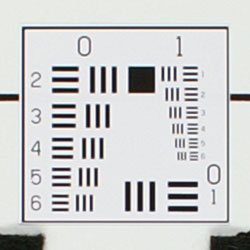 |
|
Lower left corner, wide angle
|
Center at wide angle (for comparison).
|
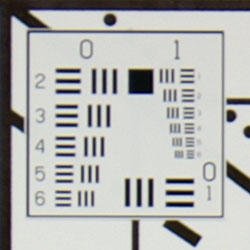 |
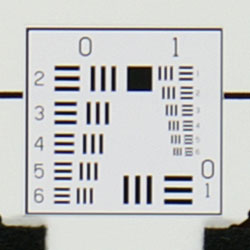 |
| Upper right corner, telephoto | Center at telephoto (for comparison) |
The Konica Minolta Maxxum 5D showed the expected softness in the corners at both telephoto and wide angle. The examples above show the worst softening we could find among the four corners, with a sample from the center of the image for comparison.
Sensor
Exposure and White Balance
Indoors, incandescent lighting
Auto white balance had a hard time with household incandescent lighting, but the Manual option did very well. Non-flash shots required a bit less than average exposure compensation.
|
Auto White Balance (+0.7 EV)
|
Manual WB (+0.7 EV)
|
Color balance indoors under incandescent was very warm in Auto mode, with the blue flowers appearing a very dark purple. The Incandescent setting produced better results, but was still warmer than I'd personally prefer. The Manual white balance setting did very well though, producing a nice white balance with just a hint of warmth and very natural colors throughout. The shot required a +0.7 EV exposure compensation boost to get a good exposure, a bit less than average. Our test lighting for this shot is a mixture of 60 and 100 watt household incandescent bulbs. This is a pretty yellow light source, but a very common one in typical home settings here in the US.
Outdoors, daylight
The 5D held both shadows and highlights well in bright sun and captured the nuances of high key overcast scenes. Color was not oversaturated. And it didn't suffer from too much contrast. A slight under or overexposure was all it took to get the shot we expected to capture.
This was even true of our low-light indoor shots, which relied on the 5D's image stabilization to record sharp images at shutter speeds as low as 1/5 second.
See the full set of test images on our thumbnail index page.
See our collection of "Gallery" images for the Konica Minolta Maxxum 5D.
Resolution
Very high resolution, 1,350 lines of strong detail horizontally, 1,300 vertically.
Our laboratory resolution chart reveals sharp, distinct line patterns down to about 1,350 lines per picture height horizontally (1,300 lines vertically), with extinction not occurring until somewhere past 1,600 lines. In the crops below, artifacts begin to swamp the chart details at the resolutions stated above: Line width begins varying significantly, color artifacts become dominant, etc. Hence, attributing higher resolution figures to the camera doesn't accurately represent what the camera is actually resolving, vs. introducing as self-generated artifacts.
|
Strong detail to 1,300 lines vertically
|
Strong detail to 1,350 lines horizontally
|
See the full set of test images on our thumbnail index page.
See our collection of "Gallery" images for the Konica Minolta Maxxum 5D.
Sharpness & Detail
Good detail, but fine details are rendered a little coarsely at the default sharpening setting.
The Konica Minolta Maxxum 5D's images contain a lot of detail, but the default in-camera sharpening settings leave the finest detail a little soft-looking, and there's just a hint of a "halo" along strongly contrasting edges. The resulting images take unsharp masking in Photoshop or other image-processing program well, but you'll want to dial down the in-camera sharpening to get the best results with post-exposure unsharp masking. At low ISOs, the Maxxum 5D's noise suppression system seems to do a pretty good job of preserving detail in areas of subtle contrast, although you can still see some sign of its operation.
ISO & Noise Performance
Images usable for large prints up to about ISO 800.
|
ISO 80
|
ISO 100
|
|
ISO 200
|
ISO 400
|
|
ISO 800
|
ISO 1600
|
|
ISO 3200
|
|
The Konica Minolta Maxxum 5D offers ISOs ranging as high as 3200, but the highest that I'd count as truly useful is ISO 800. Shots at ISO 1600 are usable for prints 8x10 inches and smaller, but are still a little rough, and the noise pixels shift the color slightly. At ISO 3200, the noise is not terrible, but the softness resulting from noise processing is distracting, and shows up even in very small prints.
For more analytical detail on the Konica Minolta 5D's imaging behavior, including noise characteristics, read our Imatest results page.
Extremes: Sunlit and low light testsHigh resolution with good detail, somewhat high contrast, but better than average detail in strong highlights. Excellent low-light capability.
|
+0.3EV
|
+0.7EV
|
+0.7EV
"High Key" exposure setting |
Because digital cameras are more like slide film than negative film, in that they tend to have a more limited tonal range, we test them in the harshest situations to see how they handle scenes with bright highlights and dark shadows, as well as what kind of sensitivity they have in low light.
The Konica Minolta Maxxum 5D did fairly well here, but did tend to lose a fair amount of highlight detail at exposures that left the midtones an acceptable brightness. Shadow detail was quite good, albeit with rather high noise levels in the blue channel. (No doubt due to how dark the shadows were, as a result of the contrasty tone curve.)
While we suspect it would have had a greater effect on a subject that was predominantly white or light in color, the 5D's "High Key" exposure option did seem to do a slightly better job of holding onto highlights, while keeping the midtones a little lighter.
The Konica Minolta Maxxum 5D did very well in our low light shooting test, capturing very bright images down to the lowest limit of our test. (About 1/16th the brightness of typical city street lighting at night, four f-stops down from typical urban light levels after dark.) Even at ISO 400, the shots at the lowest light levels were surprisingly clean, with relatively low image noise. The 5D's autofocus system works down to about 1/3 foot-candle with the AF-assist light turned off, and in total darkness (on nearby objects) with the AF assist enabled.
Color
Saturation & Hue Accuracy
Very appealing color: Oversaturates reds, greens, and blues somewhat, but leaves other colors (and skin tones) alone.
The other important part of color rendition is hue accuracy. Hue is "what color" the color is. On this score, the Konica Minolta 5D did much better than average, producing very hue-accurate color. It does shift cyans towards pure blues slightly, a common tactic by which digital cameras produce better-looking sky colors. Other than that though, the 5D has more accurate color than that of most cameras we test.
For "real world" results, see our Konica Minolta Maxxum 5D Photo Gallery for more shots taken with the camera.
For more analytical detail on the Konica Minolta 5D's imaging characteristics, read our Imatest results page.
Viewfinder
Coverage
The optical viewfinder is very slightly tight, but more accurate than those of most d-SLRs.
|
18mm optical viewfinder
|
70mm optical viewfinder
|
The Maxxum 5D's optical viewfinder shows 96-97% of the captured scene. Most digital SLRs show about 95%, relatively few higher-end models have true 100% viewfinders.
Flash
Coverage and Range
The Konica Minolta Maxxum 5D's flash offers average illumination, but still effective out to about the 14 foot limit.
|
18mm
|
70mm
|
| Normal Flash +1.0 |
Slow-Sync Mode +0.7
|
| (Relatively strong incandescent room lighting) | |
Flash coverage at wide angle shows significant vignetting, but the lighting is uniform at telephoto focal lengths.
The flash on the Konica Minolta 5D showed fairly typical exposure characteristics, requiring +1.0 EV exposure compensation on the Indoor Portrait shots shown above, a pretty typical amount for that subject. In normal mode, the flash overpowers the incandescent lights as expected, but balances the two in Slow-sync mode.
In our low light flash range test (above) the Maxxum 5D's flash did pretty well, with no falloff in brightness until somewhere a bit past 12 feet, even with the relatively "slow" f/5.6 kit lens.
Output Quality
Print Quality
Good print quality, good color, good-looking prints to 11x14 inches, and 13x19s are entirely suitable for wall display. ISO 1600 images are rough at 8x10, good at 5x7. ISO 3200 images are only acceptable at 4x6.
Testing hundreds of digital cameras, we've found that you can only tell just so much about a camera's image quality by viewing its images on-screen. Ultimately, there's no substitute for printing a lot of images and examining them closely. For this reason, we now routinely print sample images from the cameras we test on our Canon i9900 studio printer, and on the Canon iP5200 here in the office. (See the Canon i9900 review for details on that model.)
The Konica Minolta 5D's low ISO shots printed up very nicely on both the iP5200 and i9900, with good contrast, sharpness and very natural-looking color. Its images hold together well as you enlarge them. They make very sharp-looking 8x10 inch prints, and acceptable 11x14 inch ones. At 13x19 inches, they look soft up close, but perfectly fine at normal viewing distances, hung on a wall.
Turning to the 5D's high-ISO shots, its ISO 800 images looked surprisingly good at large sizes, and were quite acceptable when printed at 8x10. ISO 1600 shots looked rough at 8x10, but would probably be OK hanging on a wall where they wouldn't be scrutinized too closely. At 5x7, the ISO 1600 shots looked pretty decent, and just fine at 4x6. At ISO 3200 though, things fell apart a bit, really only looking acceptable at 4x6 inches, and even there, color and saturation suffered. Color-wise, the Konica Minolta 5D's images looked great when printed on the iP5200, with bright, vibrant color, and beautiful tonality.
Timing and Performance
Konica Minolta Maxxum 5D Timing
Only average performance in most parameters
| Startup/Shutdown: | |
| Power On to first shot | 1.4 seconds |
| Shutter response (Lag Time): | |
|
Full Autofocus Wide
|
0.30 second
|
|
Full Autofocus Tele
|
0.29 second
|
|
Prefocused
|
0.12 second
|
| Cycle time (shot to shot) | |
| Normal large/fine JPEG | 1.28 seconds (0.59 with Instant Review mode off) |
| Flash recycling | 1.31 seconds |
| Continuous mode | 0.36 second 2.79 frames/second (6 large/fine frames) |
| Download speed | |
| Windows Computer, USB 2.0 | 815 KBytes/sec |
On the timing front, the Konica Minolta 5D scored about average in our test results, though the AF system seemed to be pretty quick, comparable to the fastest digital SLR systems. USB 2.0 transfer speed was on the low side of the "high speed" spec, but still fast enough that most users should find no need of a standalone card reader.
Battery Life
Konica Minolta Maxxum 5D Battery Life
Really excellent battery life.
The Konica Minolta Maxxum 5D uses an NP-400 rechargeable lithium-ion battery pack for power, or the optional AC adapter. The camera comes with a battery and charger and shows excellent battery life, but I highly recommend picking up a spare and keeping it freshly charged at all times.
Here are the estimated run times, based on a single lithium-ion cell:
|
|
(Minutes) |
| Capture Mode, LCD |
|
| Image Playback, LCD |
|
Like most digital SLRs, the 5D's battery life is excellent, largely because it doesn't have to keep the CCD and LCD clocking away to frame its shots. With run times of over 6 hours in record mode (with the LCD off) and 2.5 hours in playback, a fully charged NP-400 battery will last most photographers all day. If you plan lots of shooting in continuous mode though, I'd suggest picking up an extra battery pack.
The Bottom Line
| Pro: | Con: |
|---|---|
|
|
Conclusion
| Free Photo Lessons | |
|

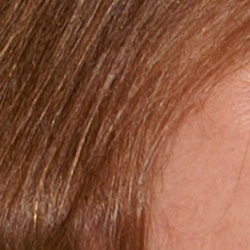
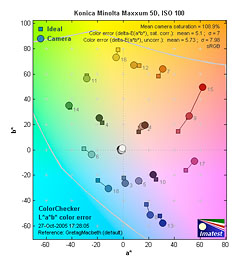


Follow Imaging Resource: